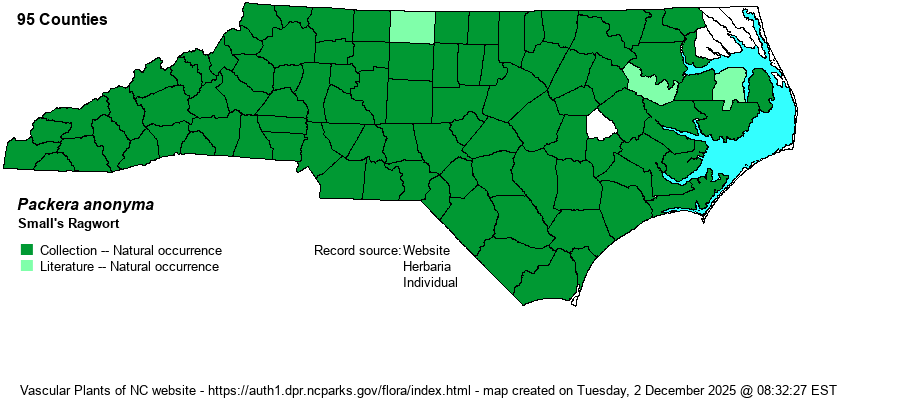| Author | (A. Wood) W.A. Weber & A. Love | |
| Distribution | Throughout the state, though absent from the Outer Banks and perhaps a few northeastern counties.
NY to OH and AR, south to northwestern FL and LA. | |
| Abundance | Common to locally abundant in the Mountains, Piedmont, and most of the Coastal Plain; rare to uncommon in the eastern counties. This is one of the more numerous spring-flowering composites in the state. | |
| Habitat | Dry to moist soil of openings and clearings in a variety of woodlands and forests, rock outcrops, trailsides, roadsides, fields, meadows, and powerline clearings. The true natural habitats in NC are not known with certainty. It is not well adapted to fire, but obviously man-made clearings do favor the spread of the species. | |
| Phenology | Flowering and fruiting mid April - early June. | |
| Identification | Ragworts generally grow 1-2.5 feet tall, with long and narrow basal leaves that become smaller and sessile upstem. The inflorescence is branched and rather flat-topped, with golden yellow rays and orange-yellow disks. Distinguishing among the species can be challenging. Note that practically all our species posess cobwebby hairs (tomentose or floccose) on stem bases and leaf axils early in the season. Use any and all keys with care and caution. Small's Ragwort has normally undissected leaves, but some can be quite dissected into many narrow lobes, especially along the stem. Leaves are tapered to the leafstalk (vs. heart-shaped or rounded) and the mature plant is essentially glabrous. It has 20-100 heads (vs. 5-20 in P. crawfordii and P. paupercula). This is a weedy native, but very showy, especially as it can grow in stands of hundreds of plants. Thus, it is generally the species that must be ruled out when attempting to identify much rarer species such as P. paupercula, P. crawfordii, and P. millefolium. | |
| Taxonomic Comments | Long placed in the genus Senecio as S. smallii or S. anonymus.
| |
| Other Common Name(s) | Appalachian Ragwort, Southern Ragwort | |
| State Rank | S5 | |
| Global Rank | G5 | |
| State Status | | |
| US Status | | |
| USACE-agcp | FACU link |
| USACE-emp | UPL link |

